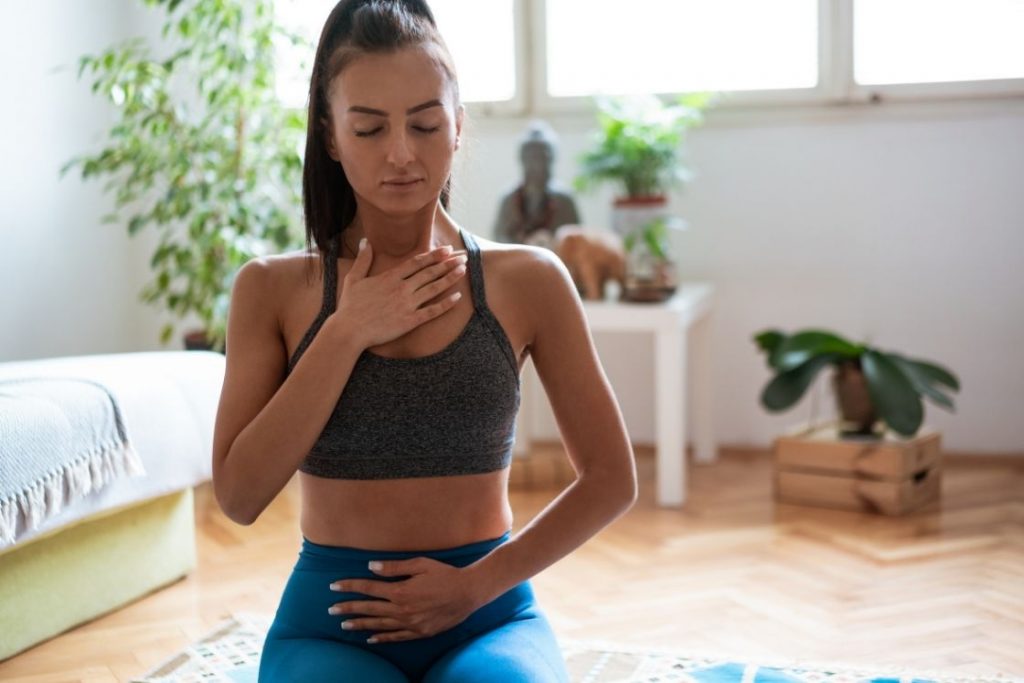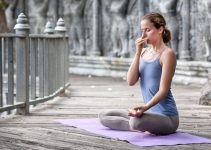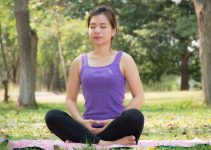
Breathing is something that we often don’t pay attention to. It’s an involuntary function of the body that doesn’t require a conscious effort which is why it is often neglected.
However, breathing is at the core of yoga practice. In fact, it’s “breath” only that sets yoga apart from other forms of physical exercise.
In yoga, we learn breathing fundamentals as a totally separate practice in the form of Pranayama. There are various pranayama types we do in yoga.
Yogic breathing is a way of breathing during yoga. In its practice, we learn in which body movements one should inhale, when one should exhale, how the abdomen should move during breathing etc.
Yogic breathing teaches you the way you can correct and maintain your breathing pattern, not only during yoga practice but in general life as well.
Also known as 3 part breathing, learning yogic breathing can help you create a balance within the body and aid in detoxification.
In this article, we will look into the various aspects of yogic breathing such as its technique, its effects on our lungs and nervous system, and the importance of breathing through the nose instead of the mouth. You will also learn a few tips on how you can breathe while performing yoga asanas and the benefits.
The 3 parts of yogic breathing
When we talk about yogic breath, we talk about breathing deeply while engaging 3 parts of the upper body – the abdomen or diaphragm, thoracic or the chest, and clavicular or the upper chest. This is also the reason yogic breathing is also known as 3 part breathing.
If you are a beginner in yoga practice, your teacher may first ask you to practice these patterns individually to understand the mechanism. Once you have mastered them, combining them in one breath leads to a full yogic breath.
Let us have a look at them individually:
1. Abdominal or diaphragmatic breath
Diaphragmatic breathing is considered to be the most efficient way of breathing and babies are an expert in this.
In diaphragmatic breathing, you engage your abdomen to take in a long deep breath (inhale and exhale) with passive movement of the chest and lungs. This breathing pattern helps you understand and get an awareness of the air movement in the lower part of your lungs.
To practice this separately as a stand-alone exercise, sit or lie down in a comfortable position. Place your right hand on your abdomen and your left hand on your chest.
Initially observe your breath as it is for a minute. Relax your abdomen and take in a deep breath, expanding your belly. Feel the rise of your abdomen with your right hand.
Do not restrict the abdominal muscles to move as it will happen naturally.
Make sure that your chest is not expanding as dramatically as your belly and remains passive in its movements.
In the same manner, let out all your breath so that your belly contracts, as if you were deflating a balloon.
The length of the inhales and exhales should be the same.
2. Thoracic Breath
In thoracic breathing, you are focusing on breathing through the lungs. By quickly drawing in air, the concentration of air in the thoracic area supports the body during physical exertion. It increases the awareness of the middle lobes of the lungs.
Increased awareness will aid in recognizing when you have started thoracic breathing and move to diaphragmatic breathing when required.
Once you have mastered diaphragmatic breathing, bring your hands upwards and place them on the side of your rib cage.
Take a deep breath and feel your rib cage expanding sideways. Notice the expansion and upward movement of the chest without the movement of the abdomen.
Exhale while relaxing the chest muscles and slowly pushing out the air by contracting the rib cage.
3. Clavicular Breath
You should only start clavicular breathing when you have perfected the above two breathing. Clavicular breathing brings awareness to the upper lobes of the lungs and the base of the neck.
The body automatically transitions to clavicular breathing from the thoracic breathing when the physical exertion creates more strain on the cardiac and respiratory systems. This helps in quick and maximum oxygen intake.
It is also a hard breathing technique to achieve and may be uncomfortable in the initial stages.
For clavicular breath, start with thoracic breathing. Deeply inhale to expand the ribs to their maximum capacity. Inhale further until you feel the upper lungs expanding, till your collarbones, and shoulders are pulled up slightly.
Slowly and gently exhale, first from the upper chest and collarbones and then from the entire rib cage.
Perform clavicular breath for not more than 5 breaths regularly.
How to do yogic breathing?
To perform a yogic breath, you will first need to master the 3 parts of breathing, as described above, separately. Once that is successfully completed, you can combine these components and perform full yogic breathing during any practice.
Below are the steps to perform full yogic breathing:
- Find a quiet spot and sit in a comfortable position. Relax your body and bring your focus to your breath.
- Spend 1 minute analyzing your breathing pattern. Do not force your breathing to change.
- On your next inhale, take a deep breath from nose and fill it to the abdomen. Let it expand as much as it can.
- Keep inhaling to now fully expand the rib cage (thoracic) and then focus on the upper lungs (clavicle).
- Your shoulders and collarbones will move up slightly.
- Slowly and gently start exhaling in the reverse order – first the collar bone, upper chest, middle chest, and finally the abdomen.
- If possible, hold your breath after full exhalation for 3-5 seconds.
Repeat this process before any yoga practice, meditation, or pranayama to relax your mind and body.
How does yogic breathing work?
Yogic breathing brings all the organs of the respiratory system into active usage. Starting from the nose, the air is drawn into the abdomen, then into the lower lobes of the lungs and finally, the upper lung lobes are filled.
Here’s how yogic breathing works:
Breathing and Lungs
The diaphragm, located beneath the lungs, is the key breathing muscle.
When we inhale, the lungs contract and pull down and expand from the bottom and outward. This causes your chest to push outwards and upwards.
The diaphragm compresses the internal abdominal organs during this movement, leading to pushing the abdomen outwards as well.
During exhalations, the diaphragm relaxes. As a result, it is pushed upward by the organs and the recoiled tissues of the lungs.
Exhalations cause the front body to move inwards.
Breathing and Nervous System
Your nervous system can become imbalanced due to a number of factors. This results in your breathing pattern changing, it becomes shallow and jerky.
Your brain interprets this as a state of distress and activates the sympathetic nervous system or the fight or flight response. This further promotes poor breathing patterns of rapid and shallow breathing and further increases distress. Your breathing gets concentrated in the upper chest area.
Remaining in this vicious cycle for too long can lead to illness and emotional and mental health imbalance.
To trigger the parasympathetic nervous system or the rest and digest mode, you must learn to recognize these symptoms and start performing yogic breathing.
A proper breathing technique can greatly help in controlling and creating a balance between sympathetic and parasympathetic responses.
Nose breathing vs. mouth breathing in yoga
Breathing through the nose is as obvious as eating through the mouth and hearing from the ears. It cannot be stressed enough that all types of yoga practices, with a handful of exceptions, have nasal breathing with the mouth closed.
In yogic philosophy, it’s said the prana (vital life force) can be absorbed by the body only when we breathe through the nose. In mouth breathing, there is the absence of Prana.
In nasal breathing, cilia, microscopic hairs that line the inside of the nose, filter, humidify, and warm or cool the air before it enters the lungs.
Your nose also produces nitric oxide (NO) during nasal breathing. NO is a vasodilator, meaning it widens blood vessels thus increasing your body’s oxygen circulation.
Nasal breathing also promotes diaphragmic breathing that can help delay the activation of fight or flight response. It will make you feel more relaxed.
Moreover, when you breathe through the nose, the air also passes through the sinuses. It is said that this area is the closest to the pituitary gland which means the air you breathe can massage this gland.
The air breathed through the nose can also greatly affect cellular respiration, the process through which the cells produce energy with the help of oxygen.
Mouth breathing
Contrary to nasal breathing, mouth breathing is sharper, shorter, shallow, and avoids the important areas of the respiratory system.
During yoga practice, mouth breathing can be done in a handful of practices, including:
- Jala Neti
- In beginner’s ujjayi breathing practice
- Releasing breaths
Releasing breaths is the most common relaxing breathing technique in which the mouth is kept open while exhaling. It’s also sighing breaths.
Mouth breathing may lead to loss of moisture inside the mouth which can result in tooth decay, gum problems, or bad breath. You may also lose excess heat which can hamper your immune system.
Most of all, it doesn’t encourage yogic breathing and balancing of the nervous system.
However, mouth breathing can be an option if you are suffering from nasal congestion, injury, or wherever it is specified.
Looking at the above, it is safe to say that you should always focus on breathing from the nose unless a yogic practice required you to inhale and/or exhale from the nose.
How to breathe while practicing yoga?
While practising physical yoga postures, it is always reinforced that you should focus on the way you breath. The timing of inhale and exhale should be perfectly aligned with a twist, forward or backward bend or a fold.
If you’re practicing in a studio, your yoga teacher will be there to guide you through each breath. In fact, in a vinyasa class, each movement between poses is synched with inhale, exhale or breath retention.
But if you’re practising yoga at home, without any guidance, it is important to keep the following breathing tips in mind:
Inhale for front opening movements
Inhale in those poses where your body movements are such that your chest and abdomen expand. This means that your body will resist to perform any movements that puts pressure on these areas.
Thus, performing back bends, chest or abdomen opening, hand or head raising asanas will require you to perform a deep inhale.
Exhale for front compressing movements
In a similar manner, when you exhale, your chest and abdomen get contracted and compressed. This makes it easier for you to perform twists, forward bend, fold, and side bends asanas easily. Performing these asanas during an inhale will restrict movement and can also cause injury.
Movement during retention of breath after inhale
After you have taken a deep inhalation and your abdomen and chest have been expanded to the max capacity, you can be told to retain your breath to prolong the effect. However you need to be aware not perform any other movements at this stage.
Your body will also naturally resist any further movements and forcing yourself can be detrimental.
Movement during retention of breath after exhale
On the contrary, your frontal body is pushed inwards and compressed after exhale. Your muscles are significantly relaxed. Retention of breath after exhalation can prolong this effect. This allows for performing movements that are allowed during exhales and your body will also not resist them.
Keep your breath deep, smooth, and effortless
A yoga practice without breathing will not give you any benefits as your breath is your guide during movements. Performing an asana should be comfortable and calm supported with deep, effortless breaths.
Also make sure that your inhales and exhales are of equal lengths to balance the intake of nourishing air and outflow of cleansed air.
If you notice your breath becoming strained, disrupted or jagged, your body has been pushed too far. It is a sign that your should take a break and bring your attention back to your breathing.
Benefits of yogic breathing
After reading all of the above, you would have gained some idea of how beneficial a proper breathing pattern can be. It promotes the trigger of parasympathetic nervous system response and helps you relax. It can support you in your exercises and all yoga practices. It can increase the flow of prana in the body and build core strength.
Some common benefits of yogic breathing are as follows:
- Reduces anxiety and stress by reducing the production of cortisol
- Enhances calm and relaxation by triggering PNS response.
- Increasing blood oxygenation and circulation.
- Stabilizes the blood pressure and heart rate.
- Improves focus due to enhanced oxygen supply to the prefrontal cortex of the brain.
- Strengthens the core.
- Can aid with sleep problems such as insomnia and sleep apnea.
- Can help with digestion and metabolism by compression on the abdominal organs.
- Production of endorphins (happy hormones) as a result of massaging of pituitary gland.
- Enhances the feeling of being grounded and anchored.
Conclusion
Yoga isn’t yoga without the breath. Yoga can also harm the body if breathing is done incorrectly. Understanding when to inhale and exhale is crucial.
Yogic breathing during meditation, yoga, and pranayama prevents any harm to the body by keeping the mind relaxed and attentive. Additionally, it can also aid in connecting your spirit to connect with spirituality on a deeper level.




